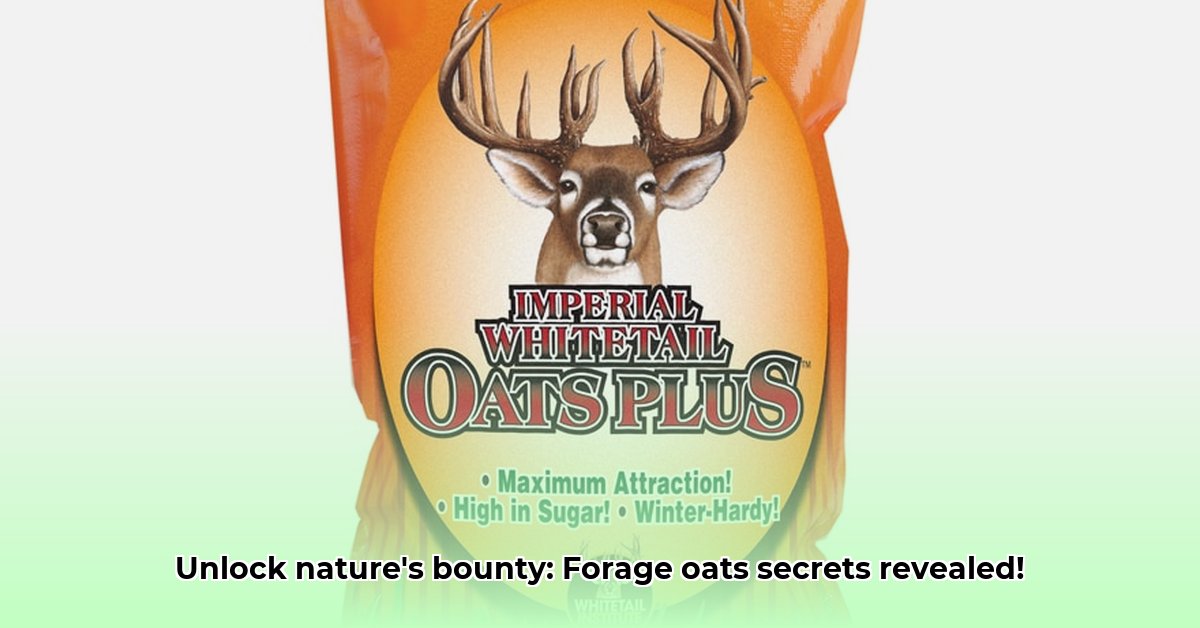
Want to create a haven for wildlife while improving your soil health? Planting a food plot with forage oats from Tractor Supply is surprisingly simple and offers significant ecological benefits. This guide provides a step-by-step approach to establishing and maintaining a thriving food plot, emphasizing sustainable practices and maximizing wildlife attraction. For other DIY projects, check out this helpful resource.
Planning Your Food Plot: Setting the Stage for Success
Before planting, careful planning is essential. Begin by selecting a suitable location. Sunlight is key; aim for an area receiving at least six hours of direct sunlight daily. Observe the sun's path across your property to identify the sunniest spot.
Next, understand your soil. A soil test (easily obtained from Tractor Supply) reveals nutrient levels and pH, guiding your planting strategy and fertilization choices. This crucial step ensures your oats receive the nutrients they need to thrive, promoting robust growth and attracting more wildlife. Don't skip this step—it's the foundation of a successful food plot. A soil test provides actionable insights, leading to a healthier and more productive plot.
Finally, choose the right oat variety. Tractor Supply offers several options; consider your climate, soil type, and target wildlife. A variety thriving in warm, humid summers might not be ideal for colder regions. Are you primarily attracting deer or birds? Researching the preferences of your local wildlife can significantly increase the effectiveness of your food plot. Consulting with experienced hunters or local wildlife experts can provide valuable insights.
Planting Your Forage Oats: A Step-by-Step Guide
Planting forage oats from Tractor Supply is straightforward, but following these steps will maximize your success:
Prepare the Ground: Till the soil to a depth of approximately six inches, creating a loose, workable structure ideal for seed germination. Remove rocks and debris for a smooth, even surface. Proper seedbed preparation significantly improves germination rates.
Spread the Seeds: Evenly distribute the oats. Follow the seeding rate recommendations on the Tractor Supply packaging meticulously. Adequate seeding ensures a dense stand, maximizing yield and wildlife attraction. Use a broadcast spreader for larger areas or sow by hand for smaller plots.
Cover and Compact: Gently rake the soil to cover the seeds lightly, protecting them from birds and maintaining moisture. Lightly roll or tamp the soil to ensure good seed-to-soil contact, improving germination and preventing seed desiccation.
Water Wisely: Thoroughly water the area after planting and maintain consistent moisture until germination. Avoid overwatering, which can lead to root rot. Regular, moderate watering is best.
Ongoing Management: Nurturing Your Food Plot
Maintaining a healthy and productive food plot requires ongoing care:
Weed Control: Weeds compete with your oats for resources. Use organic methods like mulching or hand-weeding to suppress weed growth while conserving moisture and promoting biodiversity. Mulching also reduces soil erosion.
Fertilization: Use a balanced, organic fertilizer (available at Tractor Supply) to boost growth and nutritional value. Follow instructions carefully, avoiding over-fertilization. Organic options enhance soil health and minimize environmental impact.
Pest Management: Monitor for pests and implement integrated pest management (IPM) strategies, minimizing pesticide use and protecting beneficial insects. IPM emphasizes prevention and control, fostering a balanced ecosystem.
Soil Health Monitoring: Regular soil testing (at least annually) provides valuable feedback, guiding your fertilization and management practices. This ensures long-term soil health and enhances the productivity of your food plot.
Harvesting and Wildlife Management: Reaping the Rewards
Harvesting strategies depend on your goals. Leaving some oats standing provides crucial winter forage, benefiting wildlife and enriching biodiversity. If harvesting for animal feed, cut the oats while green and moist, ensuring proper drying to prevent spoilage.
Observe your food plot regularly. Note which wildlife species visit, their feeding patterns, and any challenges they face. This informs your management strategies, creating a more effective and sustainable habitat. Adapting your approach based on your observations is key to long-term success.
Choosing Forage Oats at Tractor Supply
Tractor Supply offers a variety of forage oat seeds. Factors to consider include:
- Variety: Select based on your climate, soil, and target wildlife.
- Seeding Rate: Follow package instructions precisely.
- Cost: Balance cost per acre/square foot with yield and quality.
- Organic Options: Choose certified organic options for environmentally responsible practices and superior soil health.
Creating a sustainable food plot is a rewarding endeavor. By combining careful planning, sustainable practices, and ongoing monitoring, you can create a thriving habitat for wildlife while enhancing the health of your land. Remember, experimentation and adaptation are key to success. Enjoy the process of creating a bountiful and biodiverse food plot!